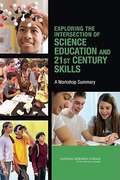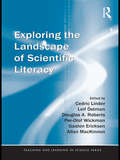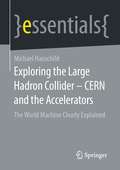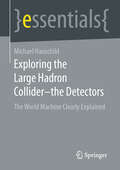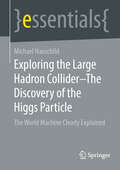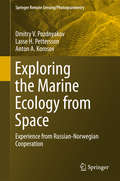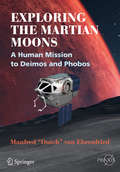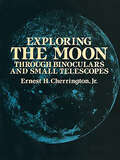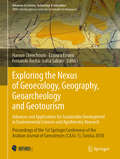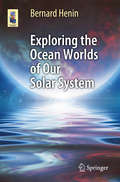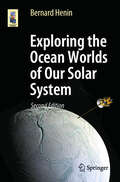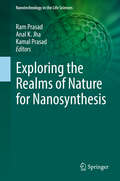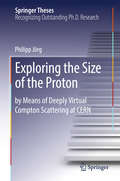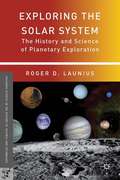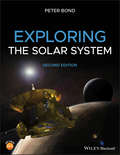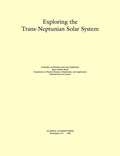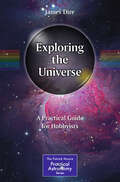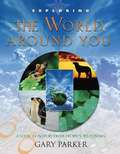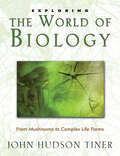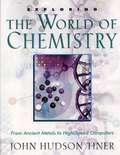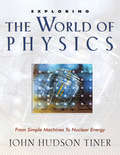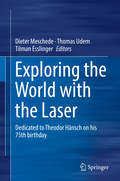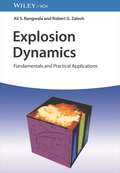- Table View
- List View
Exploring the Intersection of Science Education and 21st Century Skills: A Workshop Summary
by National Research Council of the National AcademiesAn emerging body of research suggests that a set of broad "21st century skills"--such as adaptability, complex communication skills, and the ability to solve non-routine problems--are valuable across a wide range of jobs in the national economy. However, the role of K-12 education in helping students learn these skills is a subject of current debate. Some business and education groups have advocated infusing 21st century skills into the school curriculum, and several states have launched such efforts. Other observers argue that focusing on skills detracts attention from learning of important content knowledge. To explore these issues, the National Research Council conducted a workshop, summarized in this volume, on science education as a context for development of 21st century skills. Science is seen as a promising context because it is not only a body of accepted knowledge, but also involves processes that lead to this knowledge. Engaging students in scientific processes--including talk and argument, modeling and representation, and learning from investigations--builds science proficiency. At the same time, this engagement may develop 21st century skills. Exploring the Intersection of Science Education and 21st Century Skills addresses key questions about the overlap between 21st century skills and scientific content and knowledge; explores promising models or approaches for teaching these abilities; and reviews the evidence about the transferability of these skills to real workplace applications.
Exploring the Landscape of Scientific Literacy (Teaching and Learning in Science Series)
by Cedric LinderScientific literacy is part of national science education curricula worldwide. In this volume, an international group of distinguished scholars offer new ways to look at the key ideas and practices associated with promoting scientific literacy in schools and higher education. The goal is to open up the debate on scientific literacy, particularly around the tension between theoretical and practical issues related to teaching and learning science. Uniquely drawing together and examining a rich, diverse set of approaches and policy and practice exemplars, the book takes a pragmatic and inclusive perspective on curriculum reform and learning, and presents a future vision for science education research and practice by articulating a more expansive notion of scientific literacy.
Exploring the Large Hadron Collider - CERN and the Accelerators: The World Machine Clearly Explained (essentials)
by Michael HauschildMichael Hauschild takes the reader of this essential back to the beginnings of CERN, the European Organization for Nuclear Research near Geneva, Switzerland; one of the most fascinating research centres of all, its history, its people and its accelerators. The author explains how particle accelerators work and, starting from the first ideas, how the world's largest particle accelerator, the Large Hadron Collider (LHC) was built. After a two year update, the LHC was put back into operation in spring 2015 to discover the secrets of nature with higher energy than ever before.This Springer essential is a translation of the original German 1st edition essentials, Neustart des LHC: CERN und die Beschleuniger by Michael Hauschild, published by Springer Fachmedien Wiesbaden GmbH, part of Springer Nature in 2016. The translation was done with the help of artificial intelligence (machine translation by the service DeepL.com). A subsequent human revision was done primarily in terms of content, so that the book will read stylistically differently from a conventional translation. Springer Nature works continuously to further the development of tools for the production of books and on the related technologies to support the authors.
Exploring the Large Hadron Collider - the Detectors: The World Machine Clearly Explained (essentials)
by Michael HauschildMichael Hauschild takes the reader of this essential back to September 2008 to the bumpy start of the Large Hadron Collider LHC, the world's largest particle accelerator and today's world machine at CERN, the European Organization for Nuclear Research near Geneva, Switzerland; one of the most fascinating research centers of all. The author explains how the initial ideas led to the creation of the large collaborations at the LHC, alliances of up to 3,000 physicists. It is these collaborations that use huge particle detectors to measure the collisions at the LHC, hoping to discover new particles. After a stop of more than two years, the LHC was put back into operation in the spring of 2015 to discover the secrets of nature at higher energy than ever before. The AuthorDr. Michael Hauschild is a particle physicist at CERN in Geneva and has been a member of the ATLAS experiment at the Large Hadron Collider LHC since 2005. During the first long measurement period of the LHC from 2010 to 2012, he witnessed the discovery of the Higgs particle in summer 2012.This Springer essential is a translation of the original German 1st edition essentials, Neustart des LHC: die Detektoren by Michael Hauschild, published by Springer Fachmedien Wiesbaden GmbH, part of Springer Nature in 2018. The translation was done with the help of artificial intelligence (machine translation by the service DeepL.com). A subsequent human revision was done primarily in terms of content, so that the book will read stylistically differently from a conventional translation. Springer Nature works continuously to further the development of tools for the production of books and on the related technologies to support the authors.
Exploring the Large Hadron Collider – The Discovery of the Higgs Particle: The World Machine Clearly Explained (essentials)
by Michael HauschildMichael Hauschild takes the reader of this essential back to the year 2012, when the discovery of the Higgs particle was announced at CERN, the European Organization for Nuclear Research near Geneva, Switzerland. The author vividly explains the Higgs mechanism for mass generation with the central role of the Higgs particle in current particle physics and the long hunt for its discovery at the Large Hadron Collider LHC. After a stop of more than two years, the LHC, the world‘s largest particle accelerator was put back into operation in spring 2015 to discover the secrets of nature at higher energy than ever before. An overview of future projects concludes this essential. The AuthorDr. Michael Hauschild is a particle physicist at CERN in Geneva and has been a member of the ATLAS experiment at the Large Hadron Collider LHC since 2005. During the first long measurement period of the LHC from 2010 to 2012, he witnessed the discovery of the Higgs particle in summer 2012. This Springer essential is a translation of the original German 1st edition essentials, Neustart des LHC: die Entdeckung des Higgs-Teilchens by Michael Hauschild, published by Springer Fachmedien Wiesbaden GmbH, part of Springer Nature in 2018. The translation was done with the help of artificial intelligence (machine translation by the service DeepL.com). A subsequent human revision was done primarily in terms of content, so that the book will read stylistically different from a conventional translation. Springer Nature works continuously to further the development of tools for the production of books and on the related technologies to support the authors.
Exploring the Marine Ecology from Space
by Dmitry V. Pozdnyakov Lasse H. Pettersson Anton A. KorosovThis book provides results of spatial and temporal distributions of water quality parameters and marine primary production and its relationship with the driving atmospheric, ocean circulation and hydrobiological mechanisms established through a synergistic use of multi-spectral region spaceborne data and results of numerical model simulations of marine in-water and atmospheric processes related to the marine ecosystem. The changes in the studied marine/oceanic environments are analysed in light of recent climate change that imposes its influence through a set of forward and feedback interactions and forcing.
Exploring the Martian Moons
by Manfred “Dutch” von EhrenfriedThis book explores the once popular idea of 'Flexible Path' in terms of Mars, a strategy that would focus on a manned orbital mission to Mars's moons rather than the more risky, expensive and time-consuming trip to land humans on the Martian surface. While currently still not the most popular idea, this mission would take advantage of the operational, scientific and engineering lessons to be learned from going to Mars's moons first. Unlike a trip to the planet's surface, an orbital mission avoids the dangers of the deep gravity well of Mars and a very long stay on the surface. This is analogous to Apollo 8 and 10, which preceded the landing on the Moon of Apollo 11. Furthermore, a Mars orbital mission could be achieved at least five years, possibly 10 before a landing mission. Nor would an orbital mission require all of the extra vehicles, equipment and supplies needed for a landing and a stay on the planet for over a year. The cost difference between the two types of missions is in the order of tens of billions of dollars. An orbital mission to Deimos and Phobos would provide an early opportunity to acquire scientific knowledge of the moons and Mars as well, since some of the regolith is presumed to be soil ejected from Mars. It may also offer the opportunity to deploy scientific instruments on the moons which would aid subsequent missions. It would provide early operational experience in the Mars environment without the risk of a landing. The author convincingly argues this experience would enhance the probability of a safe and successful Mars landing by NASA at a later date, and lays out the best way to approach an orbital mission in great detail. Combining path-breaking science with achievable goals on a fast timetable, this approach is the best of both worlds--and our best path to reaching Mars safely in the future.
Exploring the Moon Through Binoculars and Small Telescopes (Dover Books on Astronomy)
by Ernest H. Cherrington Jr.Informative, profusely illustrated guide to locating and identifying craters, rills, seas, mountains, other lunar features. Newly revised and updated with special section of new photos. Over 100 photos and diagrams. "Extraordinary delight awaits the amateur astronomer or teacher who opens this book." -- The Science Teacher.
Exploring the Nexus of Geoecology, Geography, Geoarcheology and Geotourism: Proceedings of the 1st Springer Conference of the Arabian Journal of Geosciences (CAJG-1), Tunisia 2018 (Advances in Science, Technology & Innovation)
by Ezzoura Errami Haroun Chenchouni Fernando Rocha Luisa SabatoThis edited volume is based on the best papers accepted for presentation during the 1st Springer Conference of the Arabian Journal of Geosciences (CAJG-1), Tunisia 2018. The book is of interest to all researchers in the fields of Environmental Sciences, Geoecology, Agroforestry, Geography, Geoarcheology and Geotourism. The Mediterranean Basin, Middle East and surrounding regions are ecologically unique due to large differences in climatic, geographical, and geological features, which grant countries of these regions with significant socio-economic potentials in terms of fertile agricultural lands, rich natural resources, and the existence of strategic resources such as crude oil and natural gas. However, the valuation of ecosystem functions, goods and services of natural and cultural heritages and bioressources of these regions is still little known. This volume offers an overview of the latest information and ideas on the physical environment of these regions, assessment and monitoring of natural bioressources including flora and fauna, and the use of cutting-edge methods for the development of sustainable agricultural systems. It gives also new socio-economic insights on geotourism and archaeology. Main topics include:1. Environmental Assessment and Monitoring of Agrisilvicultural Systems2. Environmental Impacts and Restoration Ecology of Natural and Agricultural Habitats3. Investigations and Applications in Environmental Biotechnology4. Spatiotemporal Patterns of Marine Biodiversity and Terrestrial Paleobiodiversity5. Socio-economics of Geotourism and Archaeology
Exploring the Ocean Worlds of Our Solar System (Astronomers' Universe)
by Bernard HeninIn the last 25 years, planetary science experienced a revolution, as vast oceans of liquid water have been discovered within the heart of the icy moons of our Solar System. These subsurface oceans lie hidden under thick layers of ice. We call them ocean worlds. Some of these icy moons, such as Ganymede, may hold two to three times more liquid water than all the water present on Earth, while others, such as Enceladus and Europa, are thought by astrobiologists to be our best hope of finding extraterrestrial life. In this book, we will explore and compare a variety of Solar System ocean worlds, meeting in the process 22 of the most intriguing objects, from the giant asteroid Ceres to the enigmatic, distant Sedna. In doing so, we will also encounter the multiple spacecraft that brought back most of what we know of these worlds (Pioneers, Voyagers, Cassini-Huygens, etc.), as well as the latest scientific research on this new topic. We will also entertain the possibility of life on each of these ocean worlds by assessing their habitability, as ultimately, these ocean worlds might hold the key to answering the fundamental questions in life: How did life appear? Where do we come from? Is there life out there?
Exploring the Ocean Worlds of Our Solar System (Astronomers' Universe)
by Bernard HeninIn the past 25 years, planetary science has undergone a revolution with the discovery of vast oceans of liquid water within the icy moons of our Solar System. These subsurface oceans are concealed beneath thick ice layers. We refer to these moons and similar ocean-bearing planetary objects as ocean worlds. In this 2nd edition, we delve into and compare the latest scientific discoveries on 22 confirmed or potential ocean worlds, ranging from the giant asteroid Ceres and the icy moons Europa and Enceladus to the distant dwarf planets of the outer Solar System such as Pluto, Sedna, and Eris. Along the way, we explore the contributions of multiple spacecraft, such as the Pioneers, the Voyagers, Galileo, Cassini-Huygens, and many others, which have provided much of our current knowledge about these worlds, as well as the latest scientific research on this subject. This book also explores the potential for life on each of the confirmed ocean worlds evaluating their habitability. Ultimately, these might hold the key to answering fundamental questions about life: How did life begin? Is there life beyond Earth? Where do we come from? With contributions from leading planetary scientists at NASA, ESA, and other institutions, this book aims to be the definitive reference for anyone interested in this captivating subject.
Exploring the Properties of Matter, Student Guide
by National Science Resources Center Kitty Lou Smith Susie DuckworthNIMAC-sourced textbook
Exploring the Realms of Nature for Nanosynthesis (Nanotechnology in the Life Sciences)
by Ram Prasad Anal K. Jha Kamal PrasadNature, by dint of its constitution, harbors many unassuming mysteries broadly manifested by its constituent cohorts. If physics is the pivot that holds nature and chemistry provides reasons for its existence, then the rest is just manifestation. Nanoscience and technology harbor the congruence of these two core subjects, whereby many phenomenon may be studied in the same perspective. That nature operates at nanoscale—obeying the principles of thermodynamics and supramolecular chemistry—is a well understood fact manifested in a variety of life processes: bones are restored after a fracture; clots potentially leading to cerebral strokes can be dissolved. The regeneration of new structures in our system follows a bottom-up approach. Be it a microbe (benign or pathogenic), plant (lower or higher), plant parts/organs, food beneficiaries, animal (lower), higher animal processing wastes, these all are found to deliver nanomaterials under amenable processing conditions. Identically, the molecules also seem to obey the thermodynamic principles once they get dissociated/ionized and the energy captured in the form of bonding helps in the synthesis of a myriad of nanomaterials. This edited volume explores the various green sources of nanomaterial synthesis and evaluates their industrial and biomedical applications with a scope of scaling up. It provides useful information to researchers involved in the green synthesis of nanomaterials in fields ranging from medicine to integrated agricultural management.
Exploring the Size of the Proton
by Philipp JörgThis book is a rare jewel, describing fundamental research in a highly dynamic field of subatomic physics. It presents an overview of cross section measurements of deeply virtual Compton scattering. Understanding the structure of the proton is one of the most important challenges that physics faces today. A typical tool for experimentally accessing the internal structure of the proton is lepton–nucleon scattering. In particular, deeply virtual Compton scattering at large photon virtuality and small four-momentum transfer to the proton provides a tool for deriving a three-dimensional tomographic image of the proton. Using clear language, this book presents the highly complex procedure used to derive the momentum-dissected transverse size of the proton from a pioneering measurement taken at CERN. It describes in detail the foundations of the measurement and the data analysis, and includes exhaustive studies of potential systematic uncertainties, which could bias the result.
Exploring the Solar System
by Roger D. LauniusBeginning in the early days of the Space Age - well before the advent of manned spaceflight - the United States, followed soon by other nations, undertook an ambitious effort to study the planets of the solar system. The remarkable fruits of this research revolutionized the public's view of their celestial neighbors, capturing the imaginations of people from all backgrounds like nothing else save the Apollo lunar missions. From the first space probes to the most recent planetary rovers, they have continually delivered impressive discoveries and reshaped our understanding of the cosmos. Offering fascinating investigations into this crucial chapter in space history, this collection of specially commissioned essays from leading historians opens new vistas in our understanding of the development of planetary science.
Exploring the Solar System (Coursesmart Ser.)
by Peter BondAn Exciting and Authoritative Account of the Second Golden Age of Solar System Exploration Award-winning author Peter Bond provides an up-to-date, in-depth account of the sun and its family in the 2nd edition of Exploring the Solar System. This new edition brings together the discoveries and advances in scientific understanding made during the last 60 years of solar and planetary exploration, using research conducted by the world's leading geoscientists, astronomers, and physicists. Exploring the Solar System, 2nd Edition is an ideal introduction for non-science undergraduates and anyone interested in learning about our small corner of the Milky Way galaxy.
Exploring the Solar System: A History with 22 Activities (For Kids Ser.)
by Mary Kay CarsonIn this stellar activity book, kids delve into the rich history of space exploration, where telescopes, satellites, probes, landers, and human missions lead to amazing discoveries. Updated to include the recent discovery of Eris which, along with Pluto, has been newly classified as a "dwarf planet" by the International Astronomical Union, this cosmic adventure challenges kids to explore the planets and other celestial bodies for themselves through activities such as building a model of a comet using soil, molasses, dry ice, and window cleaner; or creating their own reentry vehicle to safely return an egg to Earth's surface. With biographies of more than 20 space pioneers, specific mission details, a 20-page field guide to the solar system, and plenty of suggestions for further research, this is the ultimate guidebook to exploring the solar system.
Exploring the Trans-Neptunian Solar System
by Committee on Planetary Lunar ExplorationA report on Exploring the Trans-Neptunian Solar System
Exploring the Universe: A Practical Guide for Hobbyists (The Patrick Moore Practical Astronomy Series)
by James DireHave you ever wanted to get better at observing the universe but didn't know where to begin? Have you ever wondered what you are looking at in the night sky? Whether you are just beginning or an advanced amateur astronomer, you will want to have this book in your astronomical library. This book wraps up an entire astronomy course around the study of astronomical images, all of which have been taken by the author. The fascinating images contained herein will inspire readers to explore the descriptions of astronomical objects of all types and the physical processes they undergo throughout the universe. The author is both a career astronomy professor and an avid amateur astronomer who owns an arsenal of small telescopes for observing and conducting CCD imaging. The author’s descriptions are at a level any reader can follow. Using his own images, mostly taken with smaller telescopes as opposed to Hubble, James Webb, or multi-meter mountain top observatories, show amateur astronomers and hobbyists what can be accomplished by using modest and affordable equipment. The book begins with a primer on telescopes and the myriad types on the market today. You'll read about why there are so many models as well as the advantages and disadvantages of each. This is followed by an introduction to astrophotography, a complete description of paper and digital start atlases available today, and a discussion on celestial nomenclature – why are celestial objects named what they are named! You'll learn about light, and how it interacts with matter to create what we see in the night sky. Finally, you'll go on a grand tour of the Universe, from the Moon and Sun to comets, nebulae, star clusters and galaxies.
Exploring the World Around You
by Dr Gary ParkerIt has been said that our planet is really just an insignificant speck in a vast universe, but that's not true! In fact, the conditions for life found on earth are supremely unique and make our life here comfortable. This despite the reality that the world around us is also tainted and in need of careful calibration in order to continue. This scripturally founded book opens a window to the spectacular environments found on our planet, from deserts to the tropics, with respect to creationism. Researchers and biologist Dr. Garry Parker brings his vast knowledge of ecology to a teaching setting, exploring and explaining ecosystems, population growth, habitats, adaptations, energy problems, and much more. Learn about insect control in California, why mammals have fur, and how sharks maintain "friendships" with small fish know as remora. Exploring the World Around You brings the varieties of our planet's habitats alive to the reader, and is a wonderful learning tool complete with illustrations, chapter tests, and an index.
Exploring the World of Biology
by John Hudson TinerDISCOVER THEWORLD OF LIFE AS GODCREATED IT! The field of biology focuses on living things, from the smallest microscopic protozoa to the largest mammal. In this book you will read and explore the life of plants, insects, spiders and other arachnids, life in water, reptiles, birds, and mammals, highlighting God's amazing creatio. You will learn about the following and so much more: How does biological classification give each different type of plant or animal a unique name? In what ways are seeds spread around the world? What food does the body use for long-term storage of energy? How did biologists learn how the stomach digested food? What plant gave George de Mestral the idea for Velcro? For most of history, biologists used the visible appearance of plants or animals to classify them. They grouped plants or animals with similar-looking features into families. Starting in the 1990s, biologists have extracted DNA and RNA from cells as a guide to how plants or animals should be grouped. Like visual structures, these reveal the underlying design or creation. The newest book in our Exploring series, Exploring the World of Biology is a fascinating look at life - from the smallest proteins and spores, to the complex life systems of humans and animals.
Exploring the World of Chemistry
by John Hudson TinerChemistry is an amazing branch of science that affects us every day, yet few people realize it, or even give it much thought. Without chemistry, there would be nothing made of plastic, there would be no rubber tires, no tin cans, no television, no microwave ovens, or something as simple as wax paper. This book presents an exciting and intriguing tour through the realm of chemistry as each chapter unfolds with facts and stories about the discoveries and discoverers. Find out why pure gold is not used for jewelry or coins. Join Humphry Davy as he made many chemical discoveries, and learn how they shortened his life. See how people in the 1870s could jump over the top of the Washington Monument. Exploring the World of Chemistry brings science to life and is a wonderful learning tool with many illustrations, biographical information, chapter tests, and an index for easy referencing.
Exploring the World of Physics
by John Hudson TinerPhysics is a branch of science that many people consider to be too complicated to understand. In this exciting addition to the ?Exploring? series, John Hudson Tiner puts this myth to rest as he explains the fascinating world of physics in a way that students from elementary to high school can comprehend. Did you know that a feather and a lump of lead will fall at the same rate in a vacuum? Learn about the history of physics from Aristotle to Galileo to Isaac Newton to the latest advances. Discover how the laws of motion and gravity affect everything from the normal activities of everyday life to launching rockets into space. Learn about the effects of inertia firsthand during fun and informative experiments. Exploring the World of Physicsis a great tool for students of all ages who want to have a deeper understanding of the important and interesting ways that physics affects our lives and is complete with illustrations, chapter questions, and an index.
Exploring the World with the Laser
by Dieter Meschede Thomas Udem Tilman EsslingerThis edition contains carefully selected contributions by leading scientists in high-resolution laser spectroscopy, quantum optics and laser physics. Emphasis is given to ultrafast laser phenomena, implemenations of frequency combs, precision spectroscopy and high resolution metrology. Furthermore, applications of the fundamentals of quantum mechanics are widely covered. This book is dedicated to Nobel prize winner Theodor W. H#65533;nsch on the occasion of his 75th birthday. The contributions are reprinted from a topical collection published in Applied Physics B, 2016.
Explosion Dynamics: Fundamentals and Practical Applications
by Ali S. Rangwala Robert G. ZaloshExplosion Dynamics Structured and comprehensive introductory guide to understanding and applying explosion dynamics concepts Explosion Dynamics thoroughly explores the physical phenomena of explosions and enables readers to understand controlling variables that govern temperature, pressure, and rate of increase in pressure respectively, while also providing a mathematical framework for characterizing and applying key concepts. To promote seamless reader comprehension, this comprehensive textbook provides working examples, case studies, and assignments for self-study, as well as additional material such as property data for common gases and dusts, which supports the examples presented throughout the text. Written by two highly qualified authors, topics covered in Explosion Dynamics include: Similitude theory, similarity solutions, nonlinear systems of differential equations, gas dynamics, and chemical kinetics How a flammable mixture of gas or vapor or a suspension of powder, dust particles, or droplets forms in the industrial processing of hazardous materials Range of temperature, pressure, and concentration in which a flame can ignite and propagate How the “rate-of-pressure-rise” affects the overall explosion hazard and the viability of various explosion protection measures Providing a structured and comprehensive approach to the subject, Explosion Dynamics is an indispensable textbook that allows chemistry and engineering students, along with professional engineers and professionals in the chemical and food industries, to understand the fundamental mathematics and physics involved in explosions and develop appropriate protection and prevention measures.
